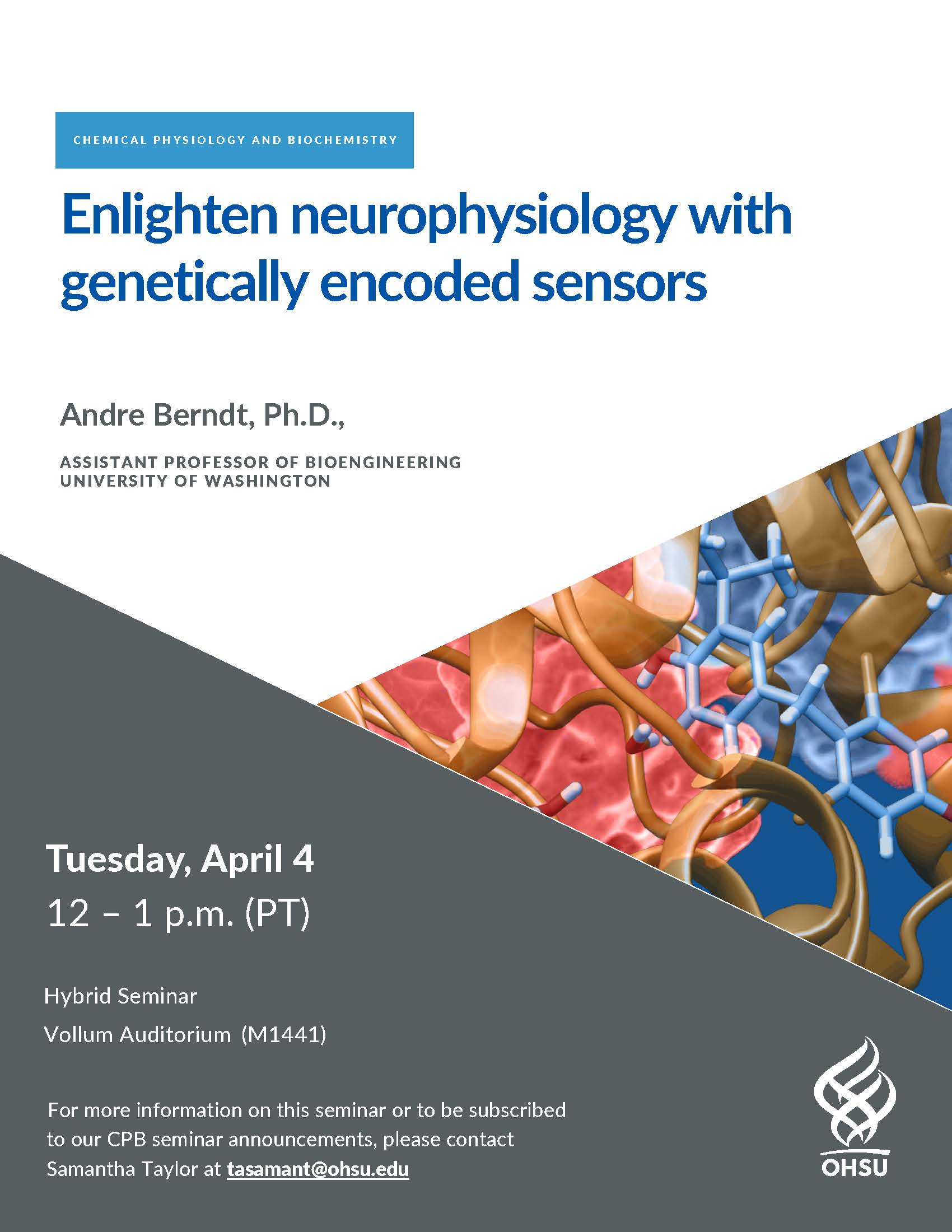Enlighten neurophysiology with genetically encoded sensors, Presented by: Andre Berndt, Ph.D., Assistant Professor of Bioengineering, University of Washington
| When |
April 4, 2023
12 p.m. to 1 p.m.

Abstract: Genetically encoded sensors, combined with fluorescent microscopy, have revolutionized real-time monitoring of dynamic physiological processes. However, the number of high-performing sensors that meet experimental needs is still limited, while there are hundreds of biological compounds for which no sensors exist. The Berndt lab develops sensors by integrating state-of-the-art approaches such as high-throughput screening, machine learning, and predictive protein engineering. These combined efforts aim to address the intrinsic complexity of protein sensors which effectively hinders the fast deployment of new tools. We engineered novel sensors for reactive oxygen species, calcium, dopamine, and opioids. Highlights are calcium indicators, predicted by machine learning ensemble models, with increased dynamic range without sacrificing calcium sensitivity and fast kinetics, red-shifted ROS sensors with reduced photobleaching, and a high-throughput pipeline suited for the development of ligand selective opioid sensors. Furthermore, we focus on optimizing multiplexed approaches, such as combining the readout of ROS and calcium from the same cells. Monitoring these processes could reveal critical insights into the pathophysiology of cardiovascular and neurodegenerative diseases and neuromodulation in motivated behaviors. Our sensors have been optimized and validated in various host systems such as mammalian cell cultures, IPSC-derived neurons and cardiomyocytes, brain slices, and behaving animals. Our future efforts aim to build custom-designed tools that meet cardiovascular and neuroscience research requirements, such as high ligand selectivity, affinity, large response amplitudes, low toxicity, fast kinetics, and cell-type and cell-type and subcellular targeting. Samantha Taylor
|
|---|---|
| Where |
Campus:
Building:
3232 SW Research Drive
Portland,
Oregon
97239
Room: M1441 Vollum Auditorium
|
| Contact Information |
Samantha Taylor
|

Abstract:
Genetically encoded sensors, combined with fluorescent microscopy, have revolutionized real-time monitoring of dynamic physiological processes. However, the number of high-performing sensors that meet experimental needs is still limited, while there are hundreds of biological compounds for which no sensors exist. The Berndt lab develops sensors by integrating state-of-the-art approaches such as high-throughput screening, machine learning, and predictive protein engineering. These combined efforts aim to address the intrinsic complexity of protein sensors which effectively hinders the fast deployment of new tools. We engineered novel sensors for reactive oxygen species, calcium, dopamine, and opioids. Highlights are calcium indicators, predicted by machine learning ensemble models, with increased dynamic range without sacrificing calcium sensitivity and fast kinetics, red-shifted ROS sensors with reduced photobleaching, and a high-throughput pipeline suited for the development of ligand selective opioid sensors.
Furthermore, we focus on optimizing multiplexed approaches, such as combining the readout of ROS and calcium from the same cells. Monitoring these processes could reveal critical insights into the pathophysiology of cardiovascular and neurodegenerative diseases and neuromodulation in motivated behaviors. Our sensors have been optimized and validated in various host systems such as mammalian cell cultures, IPSC-derived neurons and cardiomyocytes, brain slices, and behaving animals. Our future efforts aim to build custom-designed tools that meet cardiovascular and neuroscience research requirements, such as high ligand selectivity, affinity, large response amplitudes, low toxicity, fast kinetics, and cell-type and cell-type and subcellular targeting.